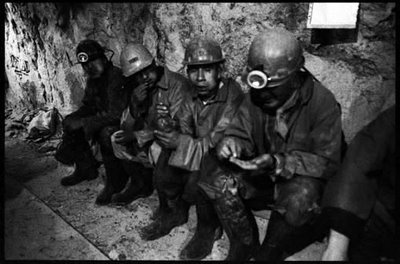More ruins... But in Todas las sangres Arguedas is less interested in physical ruins than in the fragmentation and ruination of a social order, and particularly of the dying order's dominant class.
The story concerns the transition from a feudal economy based upon agriculture to a modern, capitalist economy of mineral extraction. Such a transition is not an instance of modernization in any simple sense: mineral extraction had always been at the heart of Spanish Imperial ambitions in Peru--above all, of course, Upper Peru, now Bolivia, which contained the "cerro rico" of Potosí. So mining might also be seen as a recolonization, and what's at issue here is the competition between national and international capital, between local landowner Fermín Aragón on the one hand and the foreign corporation Wisther-Bozart on the other.

Among those caught up in the ensuing struggle are Fermín's brother, Bruno, who is the very model of an old-style landowner; Fermín's mining engineer, Cabrejos, a "faithful disciple of the North American school" (77) who is in fact in the pay of Wisther-Bozart; and Demetrio Rendón Willka, an "ex indian" whose task is to harness Don Bruno's indigenous peons in the name of the mining operation.
Cast aside, meanwhile, is the former governing class of this mining village, the "ruined notables" who have been gradually bought out by the Aragóns (81). Their houses have slowly decayed as though in sympathy with their fate:
the doors now losing their paint or varnish began to be covered in dust, and to take on the ruinousness of the walls, of the roofs, of the large courtyards and dirty arcades. The whole town started to take on an air of irredeemable age. The Aragón de Peraltas flourished by remaining on top of the desperate rival bands, untouchable. (69)But Fermín still needs the last pieces of land to which this declining aristocracy maintains its title--and Cabrejos aims to ensure that these landowners don't sell up.
At stake is a conflict not only between old capital and new, national and international, but also between the ruination suffered by the old, and the corruption embraced by the ambitious. Fermín, we are told, can no longer hear the birds that belong to a nature he views only extractively: "he has lost the gift of hearing them thanks to corrupt capital"; his wife is asked to "ensure that ambition does not continue to corrupt him" (76).
But the whole town is soon swept into a web of deceit and corruption, in which old grudges or desires are rekindled and stoked by the various competing forces: Rendón Willka's traumatic bullying at the hands of his schoolmates, or the chauffeur Gregorio's fancy for shopkeeper Doña Asusta.
Moreover, the discourse of corruption is also retranslated into meditations on cleanliness and fanaticism, both of which have premonitory resonances for the subsequent history of Sendero Luminoso in highland Peru.
Back with the novel, we'll see what plays out: whether either Bruno or Fermín can overcome the taint of the curses their father throws down at them from the church tower in the powerful scene that opens the novel; whether Cabrejos has met his match in either Fermín or Willka; and whether Willka himself can maintain his mediating role, slipping in and out of indigeneity or mestizaje as circumstances change. (My guesses: no; yes; no.)
Update: In answer to my questions... arguably Bruno does redeem himself, and perhaps so does Fermín, too; then it turns out that Cabrejos meets his match in the woman whose suitor he killed, rather than in any of the men; and at the end, mediation of any kind proves impossible, I think.
No comments:
Post a Comment